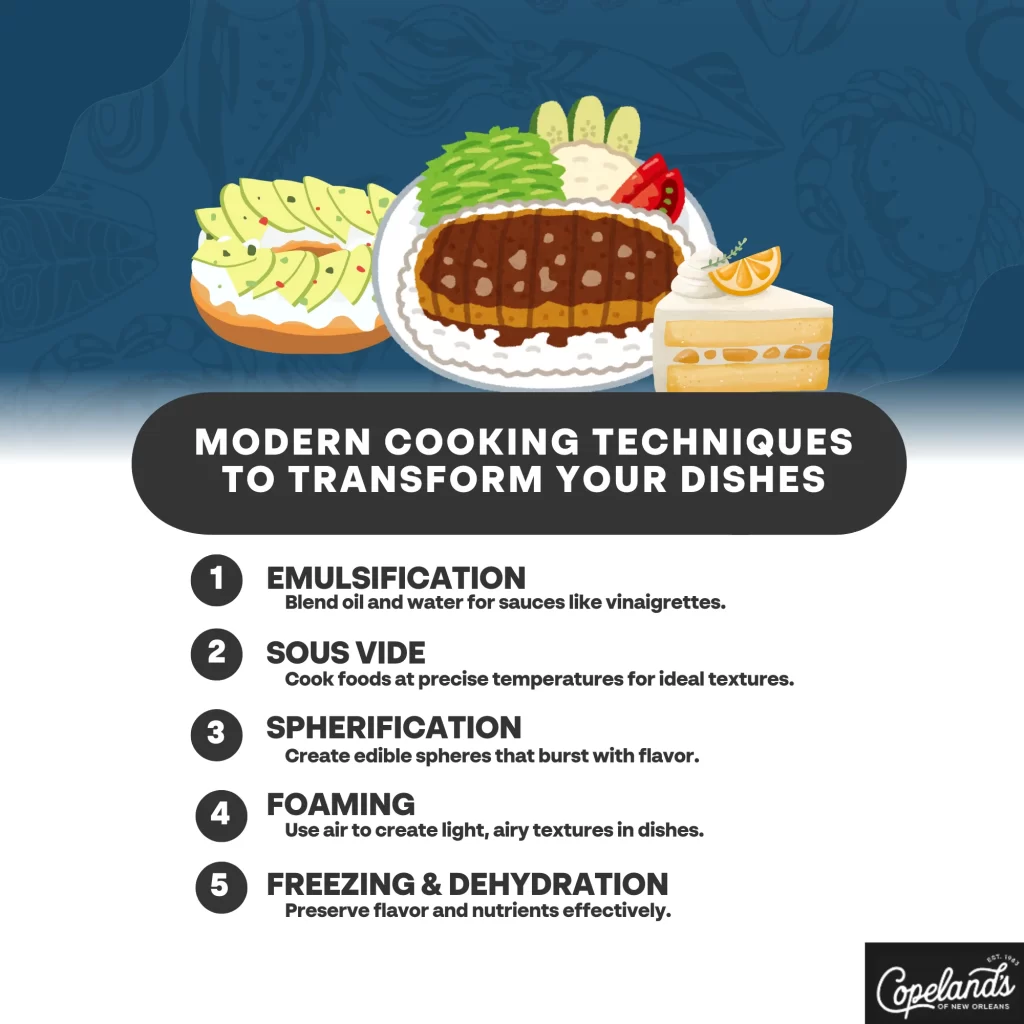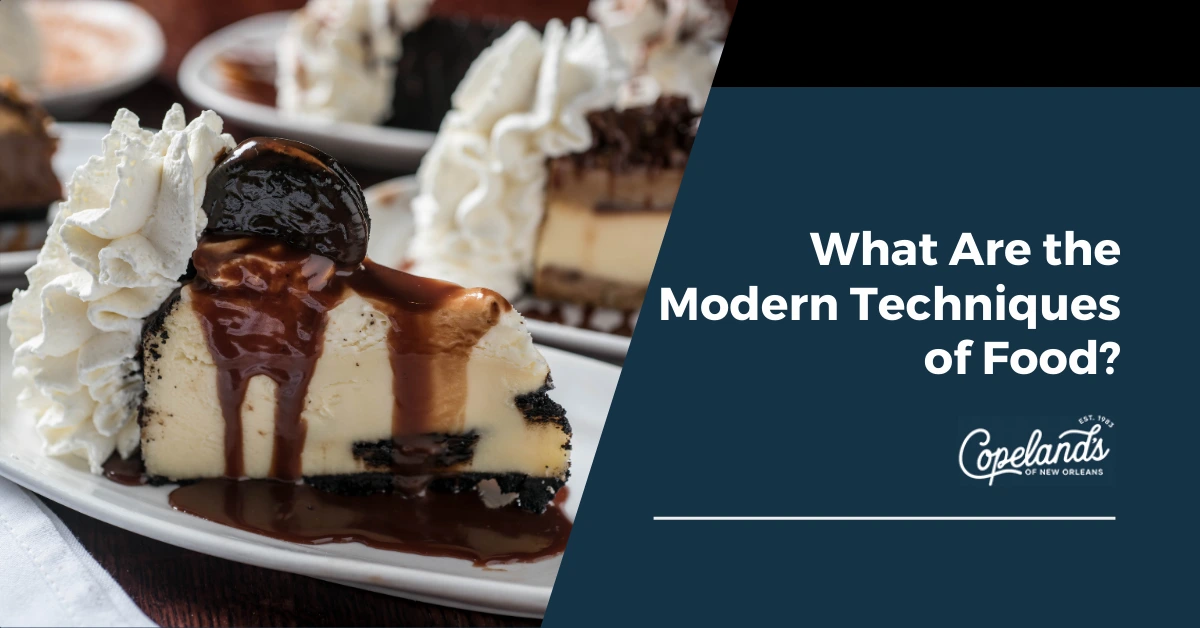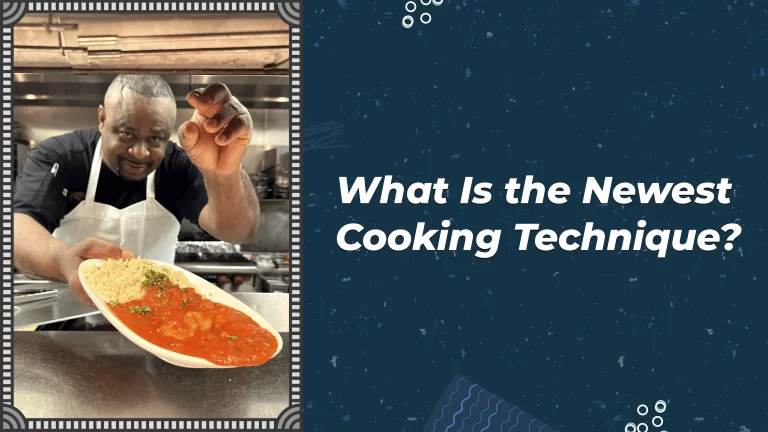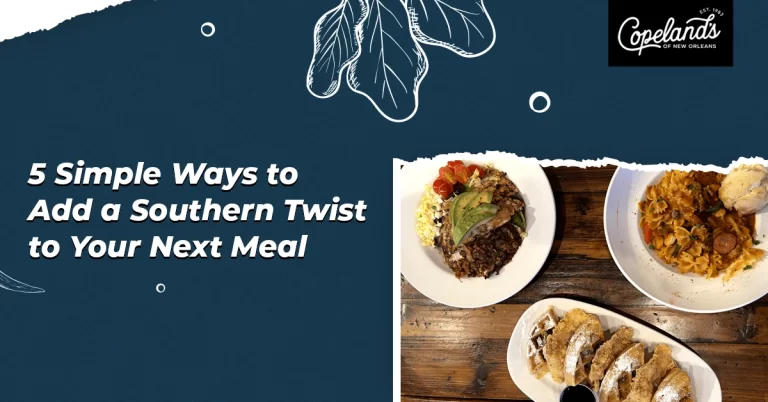Modern food techniques offer a blend of art and science to enhance your culinary experiences. You could explore emulsification techniques, such as blending oil and water to create incredible sauces. Or investigate molecular gastronomy with foams and gels, transforming liquids into airy textures or semi-solid states. Methods like freezing and dehydration work to preserve your foods’ taste and quality, while the sous vide method guarantees precisely cooked foods bursting with flavor. More innovative techniques include spherification – mixing food liquid with sodium alginate to form edible spheres. There’s a whole universe of culinary techniques waiting for you to discover.

Key Takeaways
- Modern food techniques include emulsification, which blends water and oil for even dispersion in dishes like vinaigrettes and sauces.
- Foaming methods create light, airy textures in both sweet and savory dishes, often using molecular gastronomy techniques.
- Gelling and fluid gels techniques transform liquids into semi-solid states, used extensively in sauces, dressings, and desserts.
- Sous Vide cooking involves vacuum-sealing food and cooking it in a water bath for precise temperature control, retaining moisture and enhancing flavors.
- Spherification, a molecular gastronomy technique, transforms liquid foods into spheres for innovative textures and flavors in dishes.
Emulsifying Technique
Emulsification is an integral part of modern food techniques, particularly in the domain of culinary arts like those practiced at the New Orleans Scratch Kitchen.
It’s a mechanism that allows you to seamlessly blend water and oil, two elements that ordinarily don’t mix. Essentially, emulsification breaks down the fat into tiny droplets, allowing it to disperse evenly throughout the water.
You mightn’t realize it, but you’re already applying this technique in your day-to-day cookery. Ever made a vinaigrette for your salad? That’s a rudimentary form of emulsification. When you whisk together oil and vinegar, you’re temporarily emulsifying them, creating a smooth, unified dressing.
But modern cooking techniques have elevated this process to an art form. Think of the velvety hollandaise sauce drizzled over your eggs Benedict.
That’s an emulsion of egg yolk, butter, and lemon juice, kept stable by the lecithin in the yolk. Or consider the creamy aioli you dip your fries into. It’s an emulsion of garlic, egg yolks, and olive oil, bound together by the proteins in the egg.
Emulsification, consequently, isn’t just a technique, but a culinary magic trick that transforms ordinary ingredients into extraordinary dishes.
Foams and Foaming
Stepping into the domain of modern culinary techniques, you’ll find the fascinating world of foams and foaming. A foam is a gaseous dispersion, a light, airy texture that can enhance the culinary experience. You’ll find foams in everything from your morning latte to sophisticated gourmet dishes.
The creation of foams is a science, a part of molecular gastronomy, which is one of the most exciting modern culinary techniques. Chefs use natural or synthetic surfactants, like lecithin or proteins, to stabilize air bubbles within a liquid. The result is a foam that can be sweet or savory, cold or hot, stable or unstable, depending on the dish’s requirements.
The most common technique you’ll encounter is the use of an immersion blender to introduce air into a flavored liquid, creating a light, frothy foam. But there’s also the siphon method, employing pressurized gas to create denser, more stable foams.
These techniques aren’t just about aesthetics. Foams can alter a dish’s texture, enhancing the taste and creating a memorable dining experience. As you explore modern culinary techniques, foams and foaming offer an innovative way to reimagine traditional dishes.
Fluid Gels Technique
Diving into the deep end of contemporary cooking methods, you’ll encounter the intriguing technique of fluid gels. This method, part of the broader scope of modern food processing techniques, allows for a unique textural experience in culinary creations.
Fluid gels are made by combining a liquid and a gelling agent. Once combined, they’re heated and then cooled, creating a gel. That gel is then blended into a fluid state, maintaining its ability to hold shape while delivering a smooth, creamy mouthfeel.
You’ve likely enjoyed this technique without even realizing it, in sauces, dressings, or desserts with a luxuriously smooth texture.
Understanding this technique can give you a newfound appreciation for the craft of cooking. It’s not just about combining flavors, but also manipulating textures and consistencies to create a more engaging eating experience.
As you explore the world of modern cooking, you’ll find that the fluid gels technique is just one of many innovative processes chefs are using to push the boundaries of what food can be. Mastering these techniques can elevate your cooking, turning simple ingredients into gourmet creations.
Freezing Technique
Venturing into the domain of modern culinary techniques, you’ll find the freezing method to be both simple and transformative. A cornerstone among modern food preservation techniques, freezing doesn’t just help increase a food item’s shelf life, it also maintains its nutritional value.
When you freeze food, you’re fundamentally slowing down the molecular action that contributes to spoilage. In doing so, you halt microbial growth and enzymatic reactions that degrade food quality.
You might be thinking, “Isn’t freezing just about chilling food?” Not quite. It’s about how rapidly you do it. Quick freezing leads to the formation of small ice crystals, which minimizes damage to the food’s cell structure, preserving its texture and flavor.
However, it’s not a one-size-fits-all approach. Different foods require different freezing techniques. For instance, blanching vegetables prior to freezing helps preserve color, texture, and nutritional value. Meanwhile, raw meat should be carefully wrapped to prevent freezer burn.
Employed correctly, the freezing technique can be your secret weapon in the kitchen, not just for preservation, but also for enhancing flavor and texture of your meals, a demonstration of the versatility of modern culinary techniques.
Gels and Gelling
In the domain of modern culinary techniques, gels and gelling hold a special place. This method has been embraced by chefs worldwide, thanks to modern food technology.
You see, gelling is the transformation of a liquid into a semi-solid state, offering new textures and mouthfeel experiences in dishes. It’s all about manipulating the physical and chemical properties of ingredients. You’re able to control the thickness, opacity, and elasticity of the gels.
With advanced technology, you can create soft gels, firm gels, and everything in between. For example, you might encounter a delicate gel in a dessert or a robust gel in a savory dish.
Hydrocolloids, like agar-agar and gelatin, are typically used for the gelling process. They’ve the ability to absorb water and form a 3D network, turning the liquid into a semi-solid state.
Don’t forget, temperature plays an essential role too. It can affect the setting and melting points of the gels.
Infusing Liquids and Foods
Have you ever wondered how chefs manage to infuse a symphony of flavors into your favorite dishes? This magical process is a result of one of the modern cooking methods known as infusing liquids and foods.
It’s an art form that requires mastery, precision, and creativity. Specifically, infusion involves the transfer of flavors from one ingredient to another, typically through heat. This process allows the subtle nuances of each ingredient to be thoroughly absorbed and represented in the final dish.
Here are some popular techniques:
- Cold infusion: Ideal for delicate ingredients like herbs and fruits, it involves infusing ingredients in a cold medium, usually over a long period.
- Hot infusion: Generally used for robust ingredients, it uses heat to expedite the transfer of flavors.
- Pressure infusion: A modern technique where vacuum and pressure are used to intensify the infusion.
- Alcohol infusion: Involves the use of spirits as a medium to extract and preserve flavors.
Each technique offers a unique way to manipulate and enhance flavors, adding depth and complexity to your culinary creations. Understanding and utilizing these techniques can elevate your cooking and tantalizing your taste buds in new, exciting ways.
Sous Vide Cooking Technique
While infusing liquids and foods presents a fascinating exploration of flavors, another modern cooking method invites an entirely different culinary adventure. Say hello to Sous Vide, one of the modern food production techniques that’s shaking up the culinary world.
You’re probably wondering, ‘What’s Sous Vide?’ It’s a technique where food, typically vacuum-sealed in a bag, is cooked in a water bath at precise temperatures. It’s a gamechanger, ensuring consistent results every single time.
How so? Well, it’s all about control. You dictate the exact temperature, eliminating guesswork and providing unmatched precision.
Sous Vide isn’t just for gourmet chefs. It’s been adopted by home cooks too, due to the advent of affordable Sous Vide machines. Now, you can effortlessly produce restaurant-quality dishes right in your own kitchen.
The benefits of Sous Vide extend beyond precision. It’s also a healthier option. Since the food is sealed, there’s no loss of nutrients through evaporation or leakage into the cooking liquid.
Plus, it requires less oil or fat, promoting healthier eating.
Sous Vide cooking is a shining star among modern food production techniques, transforming the way we cook and experience food. It’s about time you explored this culinary frontier.
Spherification Technique
You might think that food preparation is all about traditional cooking methods, but let’s get you acquainted with the Spherification Technique. This modern food processing technique is a game-changer, transforming liquid foods into spheres that burst in your mouth.
Spherification was first developed by Ferran Adrià, a pioneer in molecular gastronomy. It’s a process that involves two main ingredients: sodium alginate and calcium. But how does it work?
- The food liquid is mixed with sodium alginate.
- This mixture is dropped into a calcium bath.
- A reaction occurs, forming a thin gel-like skin around the liquid.
- The end result? A sphere that keeps its shape until you bite into it.
This technique allows chefs to play with textures and flavors in innovative ways, and is used in both savory and sweet dishes.
Imagine biting into a sphere of olive oil, or a tiny orb of mango juice – that’s the magic of spherification.
Thickening Technique
Beyond the domain of traditional techniques, the thickening technique plays a significant role in modern cuisine. It’s a method that’s used to enrich the texture and body of your dishes, making them more satisfying and appealing to the palate.
Modern methods of food production often employ thickening agents like flour, cornstarch, or egg yolks. But what’s interesting is the innovation you’ll see in today’s world. You’re now seeing the use of modern ingredients like xanthan gum and agar-agar, which are plant-based and offer a fantastic alternative for those with dietary restrictions.
Thickening isn’t just about adding density; it’s about enhancing the overall experience of the dish. It’s an art in itself, and mastering it can elevate your cooking skills. But remember, the key is moderation. Too little and your dish may be runny; too much and it could become gloopy.
This technique gives you the power to manipulate the consistency of your dishes and create a variety of textures. From velvety sauces to silky soups, you can transform your culinary creations.
With the right balance, you can achieve a perfect blend of flavor and texture, making every bite a delightful experience.
How to Pickle
Just as mastering the thickening technique can elevate your dishes, so too can the art of pickling. This time-honored method, which has found new life in modern food production techniques, can enhance the flavor profile of your meals while also preserving the freshness of ingredients.
- Choose your vegetables: Pickling isn’t just for cucumbers. You can experiment with carrots, peppers, onions, or even fruits like apples and pears.
- Prepare your brine: A basic brine consists of water, vinegar, and salt. You can customize this with seasonings like dill, garlic, or peppercorns.
- Pack your jars: After cleaning your vegetables, pack them tightly into sterilized jars. Pour the brine over the top, ensuring all veggies are fully submerged.
- Wait: The hardest part of pickling is waiting. Most pickles need at least a week to develop their full flavor.
How to Dehydrate.
Dehydrating is a culinary technique that’s as old as time, but with the advent of modern food dehydrators, it’s easier than ever to try at home.
You can now dehydrate a wide variety of foods using this effective and efficient method, a reflection of modern food production techniques.
To dehydrate, you’ll start by slicing your food thin, allowing for even drying. Various fruits, vegetables, and even meats work well for this technique.
Once sliced, you’ll place your food onto the dehydrator trays, ensuring they don’t overlap for the best results.
The next step is to set your dehydrator’s temperature and timer. This depends on the type of food you’re dehydrating. Fruits typically require a lower temperature than meats.
It’s important to periodically check on your food’s progress to prevent over-drying.
Once done, you’ll need to condition your food. This simply involves storing it in airtight containers for a few days, shaking occasionally to distribute any remaining moisture.
Frequently Asked Questions
What Are the Health Implications of Using Modern Food Techniques?
You’re exposed to both benefits and risks when using modern food techniques. Advancements can enhance nutrition, yet some methods may introduce harmful substances. It’s essential to stay informed and make mindful dietary choices.
How Do These Techniques Impact the Nutritional Value of Food?
Modern food techniques can greatly impact nutritional value. You’ll find that some methods, like steaming, preserve nutrients, while others, such as deep-frying, can decrease the health benefits. Always consider the cooking method for ideal nutrition.
Are These Modern Techniques Applicable to Vegetarian or Vegan Cooking?
Yes, you can apply these modern techniques to vegetarian or vegan cooking. They’ll boost flavor, texture, and even nutrition. Techniques like sous vide, molecular gastronomy, and fermentation aren’t limited to meat-based dishes.
What Are the Cost Implications of Using These Advanced Culinary Techniques?
You’ll find that utilizing modern culinary techniques might increase costs initially. You’re investing in high-tech equipment and training. However, they can streamline processes, reduce waste, and enhance food quality, potentially boosting profits in the long run.
How Can I Learn and Master These Techniques for Home Cooking?
You can master modern cooking techniques at home by enrolling in online culinary courses, reading cookbooks, watching cooking shows, and practicing regularly. Remember, practice makes perfect, so don’t be discouraged by initial failures.
Conclusion
So, there you have it. You’ve just taken a whirlwind tour of the most revolutionary culinary techniques of our time. With these skills, you can transform your humble kitchen into culinary nirvana. Remember, practice makes perfect; so don’t be afraid to whip, pickle, or spherify your way to gastronomic glory. The world of modern cooking awaits, ready to be conquered by your newfound prowess. It’s not just cooking, it’s a gastronomic revolution, and you’re leading the front!




